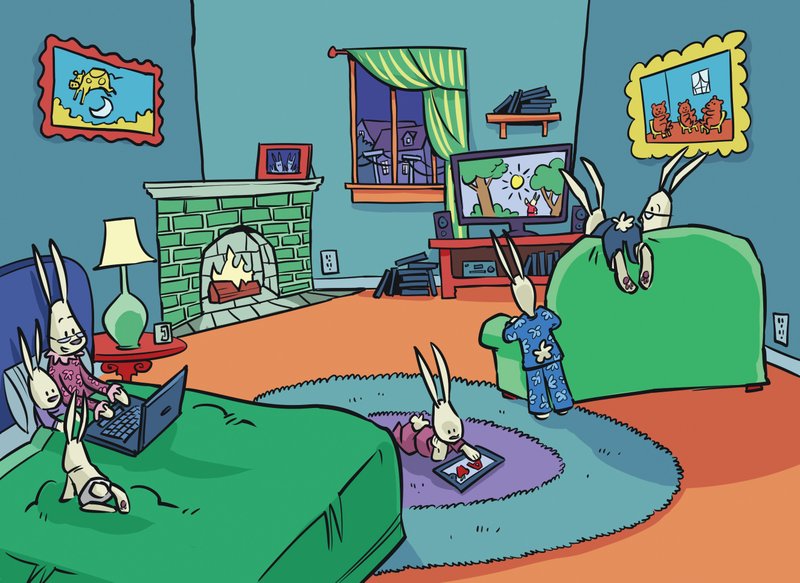Sometimes being a parent means watching the same video one too many times. But a parent's got to do what a parent's got to do.
Television, movies and videos "too often become baby sitters," says John Burgin, associate professor of early childhood education at the University of Arkansas at Little Rock. But when parents creatively engage, watching how children respond, electronic stories become building blocks in a child's development.
"Children need interaction with other children or adults," Burgin says. "Doing something with others helps them learn to solve problems and integrate experiences ... and build their attention span." So there should be limits on daily screen time. But when the family shares in screen time together, great things can happen.
Parents who actively watch what their kids watch, he says, can "bring reality into fantasy."
Yavonda Chase, mother of Alaina, 5, is one of three Democrat-Gazette staff members who contribute to the Little Rock Mamas blog, along with Heidi White and Cathy Frye. When Chase's daughter became fascinated with the octopus in the animated film Finding Nemo, she and her husband searched YouTube and other Internet sites to find short videos of a real octopus.
"We watched several videos to make sure they weren't too scary," Chase says. "Alaina loved watching an octopus releasing its ink. We want to deepen and broaden her interests." They use a number of other tools to encourage their daughter, including books, conversation and toys.
"That's a great plan," Burgin says. "She showed her daughter what a real octopus looks like; it's an excellent strategy to take a child's interest and dig deeper."
White, mother of twins Kayla and Kendall, 3, and Ava, 6, dutifully watches programs with her children, no matter how many times she has seen them.
"That way you will know where words and phrases they repeat come from," White says. "Kids that age are repeaters. Had I not been watching Peppa Pig with them, I wouldn't have understood why
Kendall called me Mama Pig. It came from that program."
Stories are studded with teaching moments.
"I always try to point out when a girl takes charge," White says. "Ava gets it. The twins will. I also point out, whether in a book or a video, when a behavior is not very nice. I remind them we don't treat people that way."
Frye's daughter, Amanda, is 11 and son Ethan is 9.
"We talk about what they're watching," she says. "When a film gets too far from real life and real people, I have no problem mocking or making fun of a scene if there is a point to be made."
The animated film Frozen has been viewed many, many times in White's and Chase's homes.
"Frozen is a wonderful movie for children with a wonderful message," Burgin says. "Disney nearly ruined fairy tales by adding happy endings instead of presenting them as they were written -- as cautionary tales. Frozen was dealing with the problems in the Cinderella story. Marry after knowing someone one day?
"The heroines of Frozen take care of themselves; their relationship was the important one."
That aspect of Frozen mattered to White and Chase.
"When princesses marry someone they've just met, I tell the girls it's not a good idea," White says. "That came up in Frozen, and the princess' guy turns out to be a bad one. That's a lesson reinforced."
"The characters in Frozen find their way. They're not perfect," Chase says, especially the older sister. "At the end, she saves herself. I'm glad to see it ... it's a long way from Sleeping Beauty."
Chase said her daughter watched Frozen daily for a couple of months.
"Kids watch those over and over; they notice new things," Burgin says. "I don't think that's a bad thing because they have sustained attention."
Burgin says the animated movie Brave also involves a heroine who takes charge of her own fate. "The relationship between the daughter and mother is interesting; it's real," he says.
STANDING GUARD
When The Hunger Games came on television one night, Frye told her children to leave the room.
"I wanted to see it first, since it's kids killing kids, how it was depicted. Now, I would let them watch it."
But life sometimes throws parents a curve.
"At age 4, Ethan developed a fear of being attacked by squirrels," Frye says. "I couldn't figure it out ... we have squirrels around our neighborhood and suddenly he was afraid of them. Then I remembered they watched movies in day care and wondered if he had seen something. ... I researched it on the Internet and discovered there was a scene in the Johnny Depp film Charlie and the Chocolate Factory that had squirrels gathering en masse and attacking. That is what scared him."
Chase says her biggest challenge is "preserving my daughter's innocence.
"So much that is on TV tends to present sarcastic 'tween lead characters. There's no need for her to get a head start on that. Animation seems to hold more innocence, but I don't let her watch the Cartoon Network ... the attitudes are not good for kids."
Burgin appreciates programs such as Thomas the Tank Engine and Friends, which he calls "wonderful," and Bill Nye the Science Guy.
"Nye explores a topic from many directions," he says. "He brings real-world activities, makes or does something and applies it to how things work."
TOO MUCH IS TOO MUCH
Still, Burgin advises caution when it comes to children's screen time.
"I would rather not see little ones watching television," he says. "Neuroscientists are recommending children shouldn't be watching TV or videos before age 2 1/2, maybe 3. The fear is, as I understand it, that [children] are not developing attention spans because TV is change, change, change."
Burgin says the brain waves of children watching TV are about as active as when one is sleeping and not dreaming.
"TV is doing all the work. It is providing the sound, the story, the visual. The brain works hard when a child is reading a book -- processing language, creating images and integrating experiences."
Children need hands-on experiences to develop their brains and attention spans, Burgin says.
"The work of early childhood is play. I would rather see a child playing with a set of real blocks than playing with blocks on a computer. The building blocks of mathematics exist in the process of stacking and balancing things such as blocks. Children need to spend time with paper, pencils, crayons ... writing and drawing.
"Kids need to have the real thing before they deal with the abstract. I'm very concerned about substituting the virtual world for the real one."
Burgin suggests parents think back to their own childhood.
"Did you have Lego? Erector set? Games? How much time did you spend on it?"
As a child, Burgin said, his passion was Lincoln Logs. "We'd build, tear it down and build again," he says.
Board games and card games have a place, Burgin says.
"It's all about cooperation, taking turns, how to handle disappointment. When you play a card game, you make decisions, predictions, look for matches and pairs and learn how to analyze and discern your next move."
Blogs by Heidi White, Cathy Frye and Yavonda Chase are at littlerockmamas.com.
Family on 09/10/2014


